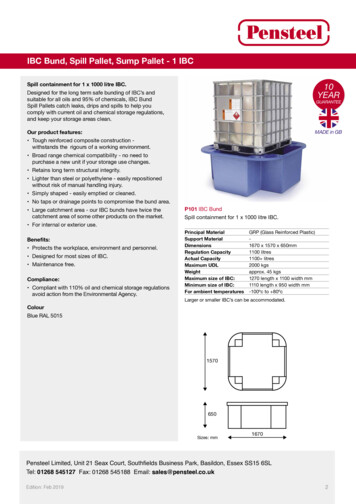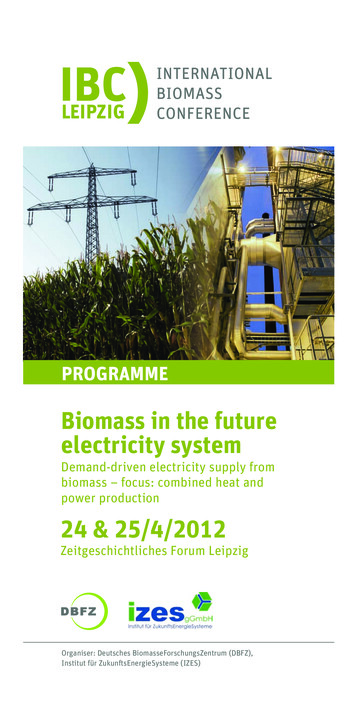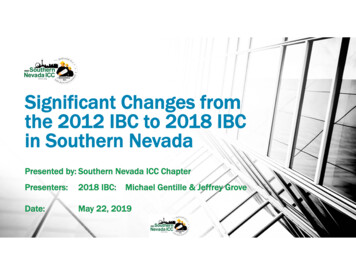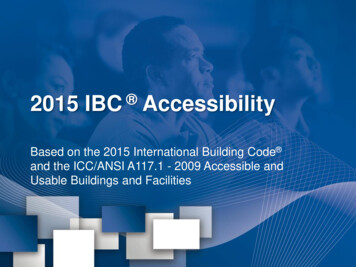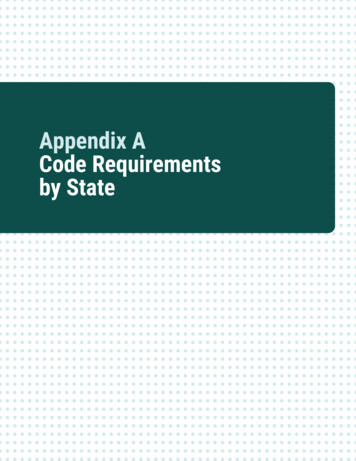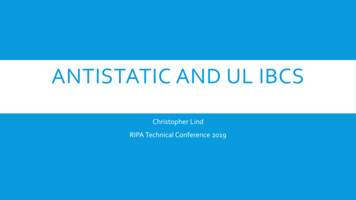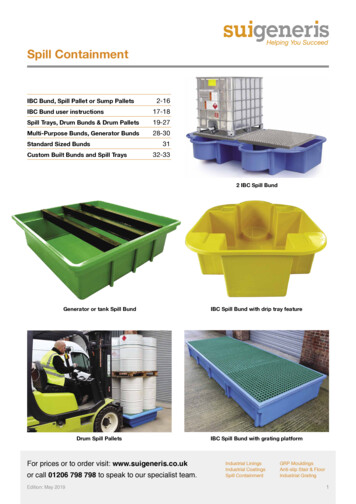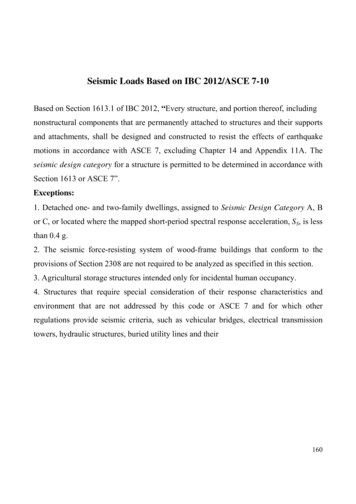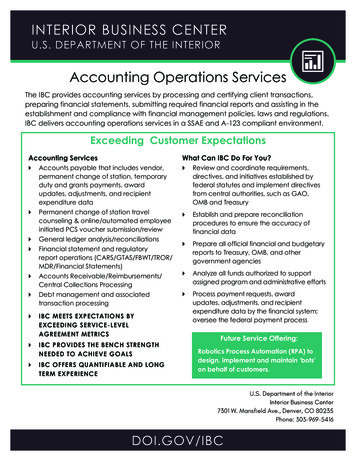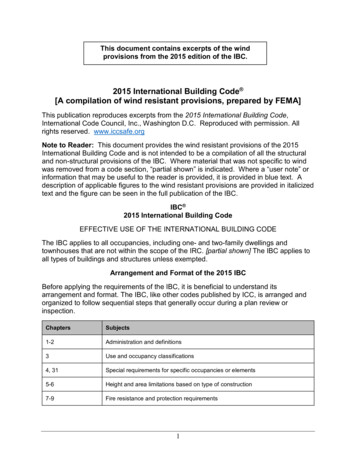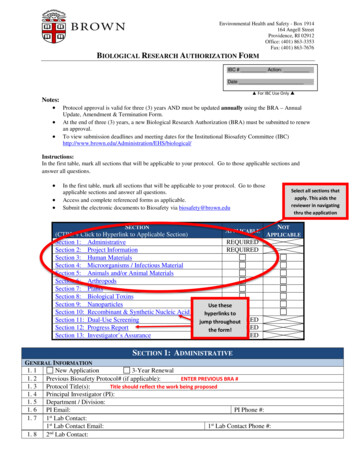
Transcription
Environmental Health and Safety - Box 1914164 Angell StreetProvidence, RI 02912Office: (401) 863-3353Fax: (401) 863-7676BIOLOGICAL RESEARCH AUTHORIZATION FORMIBC # Action:Date For IBC Use Only Notes: Protocol approval is valid for three (3) years AND must be updated annually using the BRA – Annual Update, Amendment & Termination Form.At the end of three (3) years, a new Biological Research Authorization (BRA) must be submitted to renewan approval.To view submission deadlines and meeting dates for the Institutional Biosafety Committee gical/Instructions:In the first table, mark all sections that will be applicable to your protocol. Go to those applicable sections andanswer all questions. In the first table, mark all sections that will be applicable to your protocol. Go to thoseapplicable sections and answer all questions.Access and complete referenced forms as applicable.Submit the electronic documents to Biosafety via biosafety@brown.eduSelect all sections thatapply. This aids thereviewer in navigatingthru the applicationSECTIONNOTAPPLICABLE(CTRL Click to Hyperlink to Applicable Section)APPLICABLESection 1: AdministrativeREQUIREDSection 2: Project InformationREQUIREDSection 3: Human MaterialsSection 4: Microorganisms / Infectious MaterialSection 5: Animals and/or Animal MaterialsSection 6: ArthropodsSection 7: PlantsSection 8: Biological ToxinsSection 9: NanoparticlesUse theseSection 10: Recombinant & Synthetic Nucleic Acid Moleculeshyperlinks toSection 11: Dual-Use ScreeningREQUIREDjump throughoutSection 12: Progress ReportREQUIREDthe form!Section 13: Investigator’s AssuranceREQUIREDSECTION 1: ADMINISTRATIVEGENERAL INFORMATION1. 1New Application3-Year Renewal1. 2 Previous Biosafety Protocol# (if applicable):ENTER PREVIOUS BRA #1. 3 Protocol Title(s):Title should reflect the work being proposed1. 4 Principal Investigator (PI):1. 5 Department / Division:1. 6 PI Email:PI Phone #:st1. 7 1 Lab Contact:1st Lab Contact Email:1st Lab Contact Phone #:1. 8 2nd Lab Contact:
BIOLOGICAL RESEARCH AUTHORIZATION FORM1. 92nd Lab Contact Email:2nd Lab Contact Phone #:List all locations where work will be conducted in the table below:Building(s):Room Number(s):All buildings and rooms where work is expected to take placemust be listed in this sectionProvide grantnumbers as shown inCOEUS1. 10List the funding agencies associated with this project in the table below:Funding Agency: Grant Number: Are you the primary awardee Grant Name:on the grant?YesNoYesNoYesNoYesNoBiological Authorization FormRevision Date: January 2017page 2 of 23
BIOLOGICAL RESEARCH AUTHORIZATION FORM1. 11List all individuals working on this protocol, including PI, collaborators, technicians, post docs, graduate students, undergraduate students, volunteers, etc.(attach a separate page if necessary): TRAINING NOTES: Laboratory Safety Training: Required for all individuals working in a laboratory. Required every five (5) years. Biological Safety/Bloodborne Pathogens (BBP) Training: Required for all individuals having occupational exposure to human blood, OPIM ofhuman origin (cells/cell lines, unfixed tissues) or human BBP. Required annually per OSHA. Biological Safety/Bloodborne Pathogens (BBP) Training: Required for all individuals working with biohazard agents, toxins, and recombinantand synthetic nucleic acid molecule experiments or materials. Required every five (5) years. NIH Guidelines Training: The NIH requires training on biosafety and recombinant and synthetic nucleic acid molecules. Required once per NIH.NameJob TitleDepartmentTelephone/EmailAddressRelevant Experience:How many years? What kind of Relevant Experience? (Example: 4 years’ experience intissue culture and transfecting mammalian cells)Make sure that the information provided here reflects experience relatedto the work proposed in the BRA. Include number of years of experience. Ifsomeone does not have experience, indicate how and by whom they will betrained.Biological Authorization FormRevision Date: January 2017page 3 of 23
ological Authorization FormBIOSAFETY NOTICE OF INTENTRevision Date: January 2017page 4 of 23
BIOLOGICAL RESEARCH AUTHORIZATION FORMSECTION 2: PROJECT INFORMATIONPROJECT DESCRIPTIONDISCLAIMER:The Institutional Biosafety Committee (IBC) is comprised of a diverse group of people. It is, therefore, important to uselanguage that will be detailed enough for scientific evaluation, as well as, general enough to be understood by people withnon-scientific backgrounds. Please provide sufficient information for committee members to evaluate the work forpurposes of making a biohazard risk assessment. Grant applications will only be accepted as supporting documentation.2. 1 In lay language, provide a one paragraph summary of your overall research objectives:Provide a general summary of the project. Keep in mind that not all IBC members are scientists. Make sure thissummary is written at a level that is easily understood in general terms.2. 2Explain the experimental design and research plan. Highlight the recombinant or synthetic nucleic acidmethodology used and/or the use of biological materials.This explanation should describe the specific procedures and methods used. DO NOT GIVE AIMS FROM YOURGRANT!Explain why and how specific agents are used:Describe the relationship between the work described in the Bio-Authorization and/or animal research in theIACUC application and human research from the IRB application (If applicable):2. 3Identify and describe the risk(s) to humans associated with the agents, recombinant materials (rDNA, RNA),toxins, and organisms (cell lines, animals, human materials) used in the experiment and methods that will betaken to prevent exposure.Increased risk of exposure may be associated with generation of splashes, sprays, or aerosols from centrifugation,sonication, homogenization, use of sharps (needles, glass or syringes), cage cleaning of infected animals, animalsurgeries, etc. Management of these risks should be addressed in this section.This explanation should describe the risks associated with the work and the measures that will be taken to reduceor eliminate those risks.ENGINEERING CONTROLS, DECON, & WASTEThe following engineering controls must be certified annually. The certification dates listed should be within the past 12months.2. 4 Biological Safety Cabinets (BSC) – Will this work involve the use of a BSC?Yes*No* If yes, list the BSCs being used in the following table.BSC Type (example: class II A2)Location (Bldg. & Rm#)Certification Expiration Date2. 5 Chemical Fume Hoods (CFH) – Will this work involve the use of a CFH?* If yes, list the CFHs being used in the following table.Location (Bldg. & Rm#)Certification & testdates are located on2. 6 Laminar Flow Hoods (LFH) – Do you theusefrontan LFHor clean air bench?of the* If yes, list the LFHs being used in the followingtable.equipment.Location (Bldg. & Rm#)Yes*NoTest DateYes*NoCertification Expiration Date2. 7 Biological WasteMark the type(s) of biological waste that your laboratory will produce:Biological Authorization FormRevision Date: January 2017page 5 of 23
BIOLOGICAL RESEARCH AUTHORIZATION FORMSolidLiquidSharpsPathological waste including infected or fixed animal carcasses e.g. rodents injected with lentivirus vectors,formalin, perfused animals, etc.Other:2. 8 Method of DecontaminationPlease select the method of decontamination and waste handling that applies to this work:In vitro decontamination procedures: All surfaces will be disinfected using a 1:10 dilution of household bleachwith water, made fresh daily, with a contact time of 15 minutes follow by 70% ethanol wipe to remove residue. Allsolid and semi-solid biohazardous waste will be disposed of into the Red Bag Lined Box (RBLB). All liquidbiohazardous waste will be inactivated using a 1:10 dilution of household bleach with water, made fresh daily, with acontact time of 30 minutes, and then disposed of as hazardous waste per Brown University hazardous waste policiesand procedures.In vivo decontamination procedures: All surfaces will be disinfected using one of the following disinfectants: 1:128 dilution of Chlorhexidine, made monthly, with a contact time of 2 minutes followed by 70% ethanol toremove residue 1:10 dilution of household bleach with water, made fresh daily, with a contact time of 15 minutes follow by70% ethanol wipe to remove residueAll solid and semi-solid biohazardous waste will be disposed of into the Red Bag Lined Box (RBLB). All liquidbiohazardous waste will be inactivated using a 1:10 dilution of household bleach with water, made fresh daily, with acontact time of 30 minutes, and then disposed of as hazardous waste per Brown University hazardous waste policiesand procedures.If neither of these standard methods will be used or additional procedures are required, please describe thedisinfection procedures that will be used. Please see the disinfection table for assistance with selection of appropriatemethod of decontamination.In this section, select what will be used. If additional procedures are needed or these standard procedures are notappropriate for your work, provide decon and waste handling procedures. Be sure to enter concentrations and contact timesfor disinfectants.2. 9 Use of Brown Core Facilities:Select the core facilities that will beWill you be utilizing any Brown Core facilities?(i.e., creation of transgenic mice, breeding experiments, flowused then provide details regardingcytometry)?how they will be usedYes*No* Select the Core Facility to be using:Transgenic Core – LMM 205Flow Cytometry – BMC 602Proteomics – LMM 339Structural Biology – LMM 1st floorGenomics – LMM 109XROMM – BMC GG 181Magnetic Resonance Imaging – SFH 124Other:* Explain what service(s) the Core Facility will provide for your project:2. 10 High Speed Cell SortersWill a high speed cell sorter be used in this project?* If yes, list the Fluorescent Activated Cell Sorter (FACS) being used in thefollowing table.ManufacturerYes*NoLocation (Bldg. & Rm#)If you have your own cell sorter, fill out this section. Please note that the use of a cellsorter for some materials will require the use of additional safety precautions!PERSONAL PROTECTIVE EQUIPMENTMark all PPE worn while conducting experiments under this protocol2. 11 GlovesNitrileLatexThermalCut ResistantSelect all PPE that will beOther (list):used. Safety GLASSES and2. 12 Mucous Membrane (Face) ProtectionANSI Approved Safety Glasses with Side ShieldsBiological Authorization FormRevision Date: January 2017GOGGLES are different!!!Describe how PPE will beused!page 6 of 23
BIOLOGICAL RESEARCH AUTHORIZATION FORMFace ShieldANSI Approved GogglesSurgical MaskOther (list):2. 13 Protective ClothingButton Front Lab CoatTie Back Lab CoatProtective CoverallsBootiesHair CoverScrubsOther (list):2. 14 Please provide details regarding how PPE will be used and for which procedures:EMERGENCY PROCEDURES2. 15 Reporting – Has your staff has been informed that ALL work related injuries andYesaccidental exposures (needle sticks, aspiration of aerosolized material, etc.) shallbe reported to Brown’s Insurance Office using the Brown University AccidentReport FormADMINISTRATIVE CONTROLS2. 16 Lab Signage:2. 172. 182. 192. 202. 212. 222. 232. 242. 25Select all PPE that willbe used. Safety GLASSESand GOGGLES aredifferent! Describe howPPE will be used!NoIs EHS approved entry lab signage posted and up-to-date (ex: emergency contact informationYesNo*and hazards are current)?These questions cover the shipment of*Request new or revised signage by emailing the Chemical Hygiene Officer Linda Olmsted@Brown.edumaterials, covered by the BRA, toMaterial Transfer:collaborators that may require an MTADoes the protocol involve transferring material between Brown University and a collaboratorNoand/or permits. Yesoutside the University?Do you need a Material Transfer Agreement (MTA)?YesNoTo determine if you need an MTA, refer to MTA informationDo you have an MTA?Yes*NoN/A*If needed, use the MTA Form .These questions cover theWill you be importing or exporting biological materials?Yes* to otherNoshipment or transport*If yes, contact Biosafety Officer for coordination.Brown buildings. May prompt theDo you have the appropriate transport/import permits?YesNoN/Aneed for additional training.Transportation:Does your protocol involve shipping biological material, or dry ice?YesNoWill this project involve transferring biological materials over publicYes*NoN/Athoroughfares between Brown University owned or affiliated facilities?*If yes, Materials of Trade (MOT) training will be assigned by EHS.Medical Surveillance:Yes*NoAre there any non-routine measures such as special vaccinations or additional healthscreening techniques that would potentially benefit research staff participating in orsupporting this project?*If yes, select this statement:This project involves the use of human materials. All personnel who have the potentialfor an occupational exposure to bloodborne pathogens have been offered the Hepatitis Bvaccination.If this does not apply, describe:Training:Does this protocol involve the use of human blood, other potentially infectious materialYes*No(OPIM) of human origin (cells, cell lines, unfixed tissue) or human bloodborne pathogens(BBP)?*If yes, Biosafety & Bloodborne Pathogens Training will be required annually.Biological Authorization FormRevision Date: January 2017page 7 of 23
BIOLOGICAL RESEARCH AUTHORIZATION FORMBiological Authorization FormRevision Date: January 2017page 8 of 23
BIOLOGICAL RESEARCH AUTHORIZATION FORMSECTION 3: HUMAN MATERIALS3. 13. 23. 3Does your protocol involve the use of unfixed organs or tissues from living or dead humans (except intact skin), cell lines, blood, blood products and bodyfluids, including cell cultures purchased from commercial sources?YesNo – Skip Section 3 & Go toSection 4**The use of human materials will require that an Exposure Control Plan be submitted with this application**Does your protocol involve working with live humans?YesNoDo you have IRB approval or have you submitted an IRB application?Yes*No *If yes, provide the information below. If no, contact the IRB to begin the application process.N/AIRB Protocol Title3. 43. 5StatusSubmittedApprovedNot SubmittedWill you be exposing live human subjects or human cells to recombinant and/or synthetic nucleic acid molecules?Yes*No*If yes, make sure you complete Section 10 – Recombinant & Synthetic Nucleic Acid Molecules.List all human material in the table below: Human material must be handled under BSL-2 conditions. Per OSHA requirements, all individuals withoccupational exposure to any materials listed in the table below must complete Bloodborne Pathogen training.Click here for Risk Group Classification DefinitionsMaterialTypeSourceOrigin of MaterialRisk GroupBiosafety LevelKnown Pathogense.g. Established Cell LinesIRB Numbere.g. HEK Cell Linee.g. Human KidneyChoose ItemChoose ItemChoose ItemChoose ItemChoose ItemChoose ItemFill in table with allhuman materials used.Do not leave anythingblankChoose ItemChoose ItemBiological Authorization FormRevision Date: January 2017Check all that ApplyCommercial VendorClinical SpecimensFieldInternal (ACF)OtherIf unknown state “HumanmaterialsareCommercialVendorknown to carry bloodbornepathogens.Clinical SpecimensFieldUniversal precautions will be used.”Internal (ACF)OtherCommercial VendorClinical SpecimensFieldInternal (ACF)OtherCommercial VendorClinical SpecimensFieldpage 9 of 23
BIOLOGICAL RESEARCH AUTHORIZATION FORMIf you are using humanmaterials, an exposurecontrol plan must also besubmitted with the BRA!!Biological Authorization FormChoose ItemChoose ItemChoose ItemChoose ItemChoose ItemChoose ItemRevision Date: January 2017Internal (ACF)OtherCommercial VendorClinical SpecimensFieldInternal (ACF)OtherCommercial VendorClinical SpecimensFieldInternal (ACF)OtherCommercial VendorClinical SpecimensFieldInternal (ACF)Otherpage 10 of 23
BIOLOGICAL RESEARCH AUTHORIZATION FORMSECTION 4: MICROORGANISMS / INFECTIOUS MATERIAL4. 1Does your protocol involve the use of microorganisms/infectious wild type material (bacteria, viruses,YesNo – Skip Section 4 & Go to Section 5fungi, prions, parasites)?*do not include genetically modified materials in this section*4. 2 Will you introduce recombinant/synthetic nucleic acid molecules to any microorganism/infectious agent, use recombinant DNAYes*Nomethods to change the genetic make-up of any microorganism/infectious agent, or use DNA from any microorganism/infectious agentto perform any recombinant and/or synthetic nucleic acid experiments?*If yes, make sure you complete Section 10 – Recombinant & Synthetic Nucleic Acid Molecules.4. 3 List each microorganism/infectious agent to be used in this protocol (include genus, species, and strain as applicable) in the table below.Fill in thisfor allinmicroorganismsFor more information please visit Pathogen Safety Data Sheets and Risk AssessmentortableBiosafetyMicrobiological and Biomedical Laboratoriesbeingused.Donotincludeviral vectorsClick here for Risk Group Classification Definitionsorbacteria/yeastbeingusedfor plasmidIs the agent attenuatedTypeNameIs an antibiogramDescribeanypropagation unless bacteriaare riskor fixed by serialThis agent canavailable for the(Genus,group 2 (RG-2) humanor higher!RiskBiosafetyThe agent ishealth riskspassage or otherbacterial agentsUsebetransmittedSpeciesGroupLevelhazardous to:associated with this means? If yes, attach used? If yes, attach&Strain ifvia:procedures oragent:the document.known)verifying documentsChoose Item Choose ItemChoose Item Choose ItemHumansAnimalsOther:N/AChoose Item Choose ItemChoose Item Choose ItemHumansAnimalsOther:N/AChoose Item Choose ItemChoose Item Choose ItemHumansAnimalsOther:N/AChoose Item Choose ItemChoose Item Choose oYesNoN/AYesNoYesNoN/ASELECT AGENTSDefinition: pathogens or biological toxins which have been declared by the U.S. Department of Health and Human Services or by the U.S. Department ofAgriculture to have the potential to pose a severe threat to public health and safety4. 4 Does your protocol involve any bacteria or viruses listed on the HHS/USDA Select Agents and Toxins List?Yes*Biological Authorization FormRevision Date: January 2017page 11 of 23No
BIOLOGICAL RESEARCH AUTHORIZATION FORM4. 5*If yes, please list the select agent you will be working with:If you answered yes to 4.4, is the select agent you are working with an attenuated strain or permissible toxin?Link to attenuated strain list & Link to permissible toxin list*If yes, please specify the attenuated strain or permissible toxin you will be working with:Yes*NoN/ASECTION 5: USE OF ANIMALS AND/OR ANIMAL MATERIALS5.15.25.35.45.5Does your protocol involve working with animals or animal materials?Yes*No– Skip Section 5 & Go to Section 6*If yes, please complete the table in 5.7 to provide your IACUC information.This section must be completed when using live whole animals OR any animal materials suchas tissues, cell lines, etc.IACUC Protocol NumberStatusIACUC Protocol TitleApprovedSubmittedNot SubmittedDoes your protocol involve working with animals that are field caught?Yes*No*If yes, explain:Will you be creating transgenic animals, breeding transgenic animals, exposing animals to recombinant /synthetic nucleic acid molecules,Yes*Noor purchasing /obtaining transgenic animals from a commercial vendor or collaborator?*If yes, make sure you complete Section 10 – Recombinant & Synthetic Nucleic Acid Molecules.List each animal/experiment separately in the table below:Biological Materials UsedInfectious Agents, vectors,or human cell lines used inlive cation(Ifknown)Max.Max Dose/ Method of DeliveryInfectiousCheck all that applyAnimalDose/UnitsChoose ItemInjectionIntranasalOralOcularOther:Any biohazard work in live animals mustChoose Itembe entered into this table. Fill out allcolumns. Do not leave anything blank.InjectionIntranasalOralOcularOther:Choose ItemBiological Authorization FormInjectionIntranasalOralOcularOther:Revision Date: January 2017Specify Route ofShedding/Excretion ofInfectious AgentCheck all that odNoneUnknownExplain the measures your labwill take to prevent accidentalexposure to employees, animalshandlers, students, visitors andother animalspage 12 of 23
BIOLOGICAL RESEARCH AUTHORIZATION FORMOther:5.6List the animal cell lines, tissues, transplantable tumors, and hybridomas to be used below:MaterialTypeSourceOrigin of Materiale.g. Established Cell Linese.g. COS-7e.g. Monkey kidneyAnimal materials (tissues, cell lines, etc.) must beentered into this table. Do not list any human cell lines.Do not leave any column(s) blank.Biological Authorization FormRevision Date: January 2017Check all that ApplyCommercial VendorClinical SpecimensFieldInternal (ACF)OtherCommercial VendorClinical SpecimensFieldInternal (ACF)OtherCommercial VendorClinical SpecimensFieldInternal (ACF)OtherCommercial VendorClinical SpecimensFieldInternal (ACF)OtherCommercial VendorClinical SpecimensFieldInternal (ACF)OtherCommercial VendorClinical SpecimensFieldInternal (ACF)OtherKnown Pathogenspage 13 of 23
BIOLOGICAL RESEARCH AUTHORIZATION FORMSECTION 6: ARTHROPODS6. 16. 26. 3Does your protocol involve arthropods?YesNo – Skip Section 6& Go to Section 7Will you be using, creating, or breeding transgenic arthropods or exposing arthropods toYes*Norecombinant/synthetic nucleic acid molecules?*If yes, make sure you complete Section 10 – Recombinant & Synthetic Nucleic Acid Molecules.List each arthropod used in the table below:Refer to the BMBL 5th Edition for information on Arthropod Containment Levels (ACLs).ArthropodACLChoose ItemChoose ItemChoose ItemChoose ItemChoose ItemBuildingRoomAre USDA/APHIS/ PPQ Permits Required?Yes*Yes*Yes*Yes*Yes*NoNoNoNoNo*If you answered yes, you need to complete a USDA registration form and submit it along with copies of theassociated permits to biosafety@brown.edu .SECTION 7: PLANTS7. 17. 27. 3Does your protocol involve plants?YesNo – Skip Section 7 & Go to Section 8Will you be creating transgenic plants, exposing plants to recombinant/synthetic nucleic acidYes*Nomolecules, transgenic arthropods, or transgenic microorganisms/infectious agents?*If yes, make sure you complete Section 10 – Recombinant & Synthetic Nucleic Acid Molecules.Indicate the plants used, the plant Biosafety level (BL-P) required for their housing, and where they will be housedbelow. Refer to the BMBL 5th Edition for information on BL-Ps.Are USDA/APHIS/ PPQ PermitsPlantBL-PBuildingRoomRequired?Choose ItemYes*NoChoose ItemYes*NoChoose ItemYes*NoChoose ItemYes*NoChoose ItemYes*No*If you answered yes, you need to complete a USDA registration form and submit it along with copies of theassociated permits to biosafety@Brown.eduSECTION 8: BIOLOGICAL TOXINS8. 18. 28. 3Does your protocol involve biological toxins (e.g. picrotoxin,YesNo – Skip Section 8 & Go to Section 9tetrodotoxin, diphtheria toxin, pertussis toxin, botulinumtoxin, Patulin (mycotoxin)? Note: Select Agents are in Bold above. More information on HHS/USDA Select Agents may be found on theSelect Agent Program Website.Will you be performing experiments where you clone toxin molecules with an LD50 of 100Yes*Nong/kg or less?*If yes, make sure you complete Section 10 – Recombinant & Synthetic Nucleic Acid Molecules.List each biological toxin in the table below:MaximumIs the toxin aIf Select Agent, listToxinLD50QuantityBuildingRoomHHS/USDA Selectthe permissibleon HandAgent or Toxin?amount:Yes*NoYes*NoYes*NoYes*NoBiological Authorization FormRevision Date: January 2017page 14 of 23
BIOLOGICAL RESEARCH AUTHORIZATION FORM*If you are working with a toxin that is categorized as a select agent, are you working with itwithin the permissible amounts?Guidelines for Working with Biological ToxinsYesNoSECTION 9: NANOPARTICLES9. 19. 29. 3Does your protocol involve nanoparticles?YesNo – Skip Section 9 & Go to Section 10Will you be using recombinant/synthetic DNA methods to create nanoparticles?Yes*No*If yes, make sure you complete Section 10 – Recombinant & Synthetic Nucleic Acid Molecules.List each nanoparticle in the table below:Description of the nanoparticleDescription of lab procedure involving theNanoparticle(structure, hazards, etc.)nanoparticleSECTION 10: RECOMBINANT & SYNTHETIC NUCLEIC ACID MOLECULESPURPOSE: The purpose of the “NIH Guidelines for Research Involving Recombinant or Synthetic Nucleic Acid Molecules”(NIH Guidelines) is to specify the practices for constructing and handling: Recombinant nucleic acid molecules, Synthetic nucleic acid molecules, including those that are chemically or otherwise modified but can base pairwith naturally occurring nucleic acid molecules, and Cells, organisms, and viruses containing such molecules.DEFINITION: In the context of the NIH Guidelines, recombinant and synthetic nucleic acids are defined as:i.Molecules that:a. Are constructed by joining nucleic acid molecules andb. That can replicate in a living cell, i.e., recombinant nucleic acids;ii.Nucleic acid molecules that are chemically or by other means synthesized or amplified, including those that arechemically or otherwise modified but can base pair with naturally occurring nucleic acid molecules, i.e.,synthetic nucleic acids, oriii.Molecules that result from the replication of those described in (i) or (ii) above.NOTE: Your answers to the questions in this section will allow the IBC to determine the level of review that your experimentsrequire.10. 1Does your protocol involve recombinant or syntheticYes – Click Here to go to NIH appendixnucleic acid molecules (rDNA)?No – Skip Section 10 & Go to Section 11If using more than 1 construct, list eachGeneral recombinant or synthetic nucleic acid molecule Questionsonethen list the features of each.10. 2Describe the source of the DNA/synthetic nucleic acid molecules, the nature of theinsertedDNA/synthetic nucleic acid molecules sequences, the host(s) and vector(s) to be used, if anattempt will be made to obtain expression of a foreign gene and what protein will be produced.Be sure to account for whether or not the genes involved or expressed have potential: toxicity,allergenicity or other risk to research personnel.10. 3Describe key features of the agent, virus or bacteria used in this project and if the experimentswill result in acquisition of new characteristics e.g., enhanced virulence, infectivity, drugresistance, or change in host range. Give references if appropriate.10. 4Have vector maps been submitted with this application via email?*Vector maps must be submitted via email with this application*Indicate the percent of the pathogen genome present in the vector (kilobases of the parentpathogen in the vector and packaging cell combined).10. 5Biological Authorization FormRevision Date: January 2017YesNo*page 15 of 23
BIOLOGICAL RESEARCH AUTHORIZATION FORM10. 6Will the research involve the use of antibiotic selection markers?*If yes, list the markers and microbial agents used (e.g. neomycin resistance marker in E.coli).Yes*10. 7Use of Replication-Incompetent Virus Derived Vector Systems:Will you be using a virus derived vector system that is truct,listeach*If yes, explain how this has been achieved using details, maps, references, etc. Also, describe how you will assureonereplicationthen list thefeatures ofeach.that your vector material is free from contamination bycompetentvirus.10.8.1 Will any of the sequences code for toxins?YesIf yes, indicate LD5010.8.2 If using adeno or lentivirus, will you be using third or fourth generation systems for safety?Yes10.8.3 Will VSV-G be used for pseudotyping and are you aware that this can increase the risk ofYesexposure through absorption and inhalation along with injection and ingestion?10.8.4 If using oncogene inserts, a DNA sequencing library shall be kept. Indicate the location of these records.Additional Gene Editing Questions10.8.5 Will your research involve gene editing technologies (i.e. CRISPR/Cas9, TALEN, Zinc FingerNucleases, and Meganucleases)?*If no, skip to #10.9.10.8.6 If CRISPR is involved, are the guide RNA sequence and the Cas endonuclease on the sameplasmid or delivery vehicle?*If yes, can the plasmid, vector or delivery vehicle infect a human cell?10.8.7 Does the use of CRISPR involve a viral vector?10.8.8 Is this a gene drive experiment?10.8.9 Will the research involve embryos or germ line cells (outside of standard transgenic animalprotocols)?*If yes, discuss the potential for off-target effects?10.8.10 How many genes have been targeted?Single* (List number, i.e. hundreds, thousands, more?Multiple – How ary*Number of unique vectors associated with gene editing library?Number of gene editing sequences targeting each gene in the library (per vector)?Biological Authorization FormRevision Date: January 2017page 16 of 23
BIOLOGICAL RESEARCH AUTHORIZATION FORM10.9HostUse the table below to describe your recombinant or synthetic nucleic acid experiments. Click here for Risk Group ClassificationDefinitionsHost RiskGroupClassificationChoose ItemChooseItem TheThe vector isthe construct.host (animal, cell line, etc.) iswhat the vector will be used in.When propagating plasmids,the plasmid is the vector andChooseisItemthe bacteria/yeastthe host.VectorVector RiskGroupClassificationBiosafetyLevelChoose ItemChoose ItemChoose ItemChoose ItemInsertedrecombinant orsyntheticnucleic acidmoleculesWhat is thelargest fractionof
Chemical Fume Hoods (CFH) - Will this work involve the use of a CFH? * If yes, list the CFHs being used in the following table. Yes* No: Location (Bldg. & Rm#) Test Date : . Flow Cytometry - BMC 602 XROMM - BMC GG 181 Proteomics - LMM 339 Magnetic Resonance Imaging - SFH 124 Structural Biology - LMM 1 .

